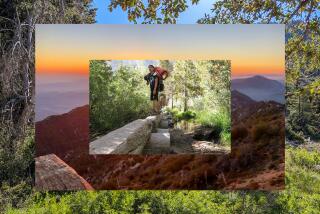A Part of Bygone Days of Calabasas Lives On
Miguel Leonis, a bearded 6-foot, 4-inch Basque from the French Pyrenees, became known as the King of Calabasas in the late 1800s. Although his dominating appearance undoubtedly contributed to the title, he was notorious as a land baron.
Leonis started his empire by marrying a widowed mission Indian, Espiritu Chujilla, whose property included 1,100 acres at the southwest end of the San Fernando Valley. He also claimed much of the surrounding acreage to graze his sheep and other livestock, and fought off settlers with physical threats and court injunctions.
In 1899, after winning a land trial, Miguel was returning from Los Angeles when his wagon overturned in Cahuenga Pass and the âkingâ was killed. His memory lives on in Calabasas at Leonis Adobe.
The vintage hacienda has been restored to recall the good life in the areaâs rough-and-tumble days, long before the valley became part of the expanding suburbia of Los Angeles. The home is open without charge Wednesday through Sunday from 1 to 4 p.m.
A Welcome Stop
Farther west in the Conejo Valley, youâll get another peek at the past with a visit to the Stagecoach Inn Museum, a state historic landmark. It began as the Grand Union Hotel, a welcome stop for stagecoach passengers bumping over El Camino Real between Los Angeles and Santa Barbara.
That royal road connecting Californiaâs early Spanish settlements also ran through Calabasas. Today itâs partially paralleled by U.S. 101, the Ventura Freeway, which offers easy access to the Leonis Adobe.
Get there by driving north from Los Angeles to the Valley Circle Boulevard-Mulholland Drive exit, go south over the freeway and turn right on Calabasas Road. Then look right for the Monterey-style ranch house with a fancy second-story wraparound porch. Itâs also marked by a windmill and front-yard garden.
Entry to the homestead is at the right end of the parking lot through the 1870s Plummer House. Once the oldest home in West Hollywood and also a state historic landmark, it was saved from demolition three years ago and moved to Calabasas.
The Plummer House serves as the visitor center for the Leonis Adobe; ask for the tour brochure and map of the grounds.
Youâll walk past the garden and grape arbor to enter the remodeled home thatâs decorated with 19th-Century antique furniture. Leonis converted a simple farmhouse to his showplace by adding rooms, enclosing porches and covering the adobe with redwood.
After you tour both the upstairs and downstairs, wander on the grounds of this once isolated but prosperous ranch. Behind the main house is a sheltered bake oven, coops with chickens and other live fowl, and a barn with a blacksmith shop.
Also look for the hangmanâs noose swinging from a dead tree in a corner of the parking lot. In frontier times when Calabasas was a haven for outlaws, the old oak stood in front of the jail. To phone the Leonis Adobe: (818) 712-0734.
The Western Flavor
Modern shops line Calabasas Road, the old El Camino Real, but thereâs some attempt to keep a Western flavor in this historic part of the town. Go next door to the adobe to the busy Sagebrush Cantina to enjoy Mexican food and country music.
Return to U.S. 101 and continue west through Thousand Oaks to the Ventu Park Road-Newbury Park exit. Turn left to cross over the freeway, follow Ventu Park Road to Susan Drive and turn right to the Stagecoach Inn Museum.
You can visit this handsome roadhouse Sunday and Wednesday through Friday from 1 to 4 p.m. Donations are welcome.
The âoldâ inn is rather new, although you wouldnât guess that itâs only a replica of the original hotel that burned to the ground in 1970. Local folks banded together to rebuild and reopen the Stagecoach Inn as a museum six years after the fire.
More than 400 artifacts salvaged from the fire are on display, and there are many others. On the museum grounds you also can inspect the homes of earlier eras: a Chumash Indian hut, Spanish/Mexican adobe and a pioneer cabin.
Docents in Victorian dress guide you around the wooden two-story building that has been refurnished with Conejo Valley furniture and mementos from the turn of the century. The main floor has a pleasant parlor, well-appointed dining room and the all-important kitchen.
Be sure to go upstairs to the ladiesâ tearoom. Most of the other second-floor rooms are tiny and accommodated overnight travelers; ask about Pierre, the resident ghost.
In a barn nearby you can inspect stagecoaches and appreciate the comfort of todayâs public transport. Follow a path to the museumâs tri-village complex to see the Spartan living quarters of bygone days.
Especially interesting is the replica of an 1876 home built by one of the areaâs pioneer families, Mr. and Mrs. Egbert Newbury. Itâs open Sunday afternoons, along with a small early California adobe. A thatched Chumash Indian hut is nearby.
Walk back to the inn along a nature trail that winds through the woods past plants once used by the Indians for food and medicine. Youâll find tables on the rear porch where visitors are welcome to picnic. The museum phone number is (805) 498-9441.
The 30th annual Conejo Valley Days will be celebrated May 3-4 in Thousand Oaks with a parade, rodeo, carnival, country fair, barbecue and more events. Details: (805) 497-1621.
Rejoin U.S. 101 south for the drive back to Los Angeles.
Round trip from Los Angeles for a return to early times in Calabasas and the Conejo Valley is 98 miles.
More to Read
Sign up for The Wild
Weâll help you find the best places to hike, bike and run, as well as the perfect silent spots for meditation and yoga.
You may occasionally receive promotional content from the Los Angeles Times.






